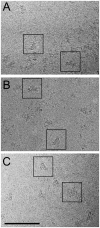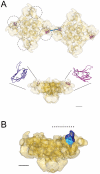3D Mapping of the SPRY2 domain of ryanodine receptor 1 by single-particle cryo-EM
- PMID: 21998699
- PMCID: PMC3187800
- DOI: 10.1371/journal.pone.0025813
3D Mapping of the SPRY2 domain of ryanodine receptor 1 by single-particle cryo-EM
Abstract
The type 1 skeletal muscle ryanodine receptor (RyR1) is principally responsible for Ca(2+) release from the sarcoplasmic reticulum and for the subsequent muscle contraction. The RyR1 contains three SPRY domains. SPRY domains are generally known to mediate protein-protein interactions, however the location of the three SPRY domains in the 3D structure of the RyR1 is not known. Combining immunolabeling and single-particle cryo-electron microscopy we have mapped the SPRY2 domain (S1085-V1208) in the 3D structure of RyR1 using three different antibodies against the SPRY2 domain. Two obstacles for the image processing procedure; limited amount of data and signal dilution introduced by the multiple orientations of the antibody bound in the tetrameric RyR1, were overcome by modifying the 3D reconstruction scheme. This approach enabled us to ascertain that the three antibodies bind to the same region, to obtain a 3D reconstruction of RyR1 with the antibody bound, and to map SPRY2 to the periphery of the cytoplasmic domain of RyR1. We report here the first 3D localization of a SPRY2 domain in any known RyR isoform.
Conflict of interest statement
Figures




Similar articles
-
The elusive role of the SPRY2 domain in RyR1.Channels (Austin). 2011 Mar-Apr;5(2):148-60. doi: 10.4161/chan.5.2.14407. Epub 2011 Mar 1. Channels (Austin). 2011. PMID: 21239886 Free PMC article.
-
Ubiquitous SPRY domains and their role in the skeletal type ryanodine receptor.Eur Biophys J. 2009 Dec;39(1):51-9. doi: 10.1007/s00249-009-0455-8. Epub 2009 Apr 28. Eur Biophys J. 2009. PMID: 19399493 Review.
-
Structural and functional characterization of ryanodine receptor-natrin toxin interaction.Biophys J. 2008 Nov 1;95(9):4289-99. doi: 10.1529/biophysj.108.137224. Epub 2008 Jul 25. Biophys J. 2008. PMID: 18658224 Free PMC article.
-
Subnanometer-resolution electron cryomicroscopy-based domain models for the cytoplasmic region of skeletal muscle RyR channel.Proc Natl Acad Sci U S A. 2008 Jul 15;105(28):9610-5. doi: 10.1073/pnas.0803189105. Epub 2008 Jul 10. Proc Natl Acad Sci U S A. 2008. PMID: 18621707 Free PMC article.
-
Molecular recognition of the disordered dihydropyridine receptor II-III loop by a conserved spry domain of the type 1 ryanodine receptor.Clin Exp Pharmacol Physiol. 2009 Mar;36(3):346-9. doi: 10.1111/j.1440-1681.2008.05130.x. Epub 2008 Nov 28. Clin Exp Pharmacol Physiol. 2009. PMID: 19076161 Review.
Cited by
-
A guide to the 3D structure of the ryanodine receptor type 1 by cryoEM.Protein Sci. 2017 Jan;26(1):52-68. doi: 10.1002/pro.3052. Epub 2016 Oct 13. Protein Sci. 2017. PMID: 27671094 Free PMC article. Review.
-
Identification of ATP-binding regions in the RyR1 Ca²⁺ release channel.PLoS One. 2012;7(11):e48725. doi: 10.1371/journal.pone.0048725. Epub 2012 Nov 7. PLoS One. 2012. PMID: 23144945 Free PMC article.
-
Subunit organization of a synechocystis hetero-oligomeric thylakoid FtsH complex involved in photosystem II repair.Plant Cell. 2012 Sep;24(9):3669-83. doi: 10.1105/tpc.112.100891. Epub 2012 Sep 18. Plant Cell. 2012. PMID: 22991268 Free PMC article.
-
TRIC-A Channel Maintains Store Calcium Handling by Interacting With Type 2 Ryanodine Receptor in Cardiac Muscle.Circ Res. 2020 Feb 14;126(4):417-435. doi: 10.1161/CIRCRESAHA.119.316241. Epub 2019 Dec 6. Circ Res. 2020. PMID: 31805819 Free PMC article.
-
Germline mutations in RYR1 are associated with foetal akinesia deformation sequence/lethal multiple pterygium syndrome.Acta Neuropathol Commun. 2014 Dec 5;2:148. doi: 10.1186/s40478-014-0148-0. Acta Neuropathol Commun. 2014. PMID: 25476234 Free PMC article.
References
-
- Sencer S, Papineni RV, Halling DB, Pate P, Krol J, et al. Coupling of RYR1 and L-type calcium channels via calmodulin binding domains. J Biol Chem. 2001;276:38237–38241. - PubMed
-
- Samso M, Wagenknecht T. Apocalmodulin and Ca2+-calmodulin bind to neighboring locations on the ryanodine receptor. J Biol Chem. 2002;277:1349–1353. - PubMed
-
- Samso M, Shen X, Allen PD. Structural characterization of the RyR1-FKBP12 interaction. J Mol Biol. 2006;356:917–927. - PubMed
-
- Wagenknecht T, Radermacher M, Grassucci R, Berkowitz J, Xin HB, et al. Locations of calmodulin and FK506-binding protein on the three-dimensional architecture of the skeletal muscle ryanodine receptor. J Biol Chem. 1997;272:32463–32471. - PubMed
Publication types
MeSH terms
Substances
Grants and funding
LinkOut - more resources
Full Text Sources
Miscellaneous

